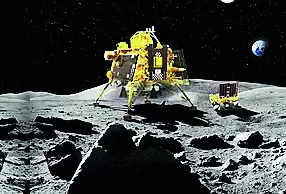For uneducated, 14 days Earth equal to one lunar day. The lunar day began on August 22; Chandrayaan-3 landed at the end of the second day and in just 10 days its rover passed more than 100 meters on the lunar surface.
At this time, both Chandrayaan-3’s robotic rover Pragyan and Vikram Moon Lander have been safely parked and placed in „sleep mode” till September 22, 2023, which will endure a night on the Moon, which will last for 14 days. When the sun rises on the moon At the South Pole On September 22, Pragyan is expected to wake up for more work.
Here we list four notable discoveries about the Moon by ISRO’s Chandrayaan-3 mission, as reported by Nature. These findings have attracted significant attention from scientists around the world:
1. Ionosphere Intelligence: Chandrayaan-3’s lander, Vikram, analyzed the moon’s ionosphere — the atoms and molecules in its upper atmosphere that are ionized by sunlight. It measured the density and temperature of this region, revealing a concentration of ions and electrons with densities ranging from 5 million to 30 million electrons per cubic meter. This density changes during the lunar day, an ISRO scientist told Nature.
The low density of electrons in the moon’s ionosphere enables radio signals to travel faster–an important factor to consider if humans look to lunar settlements in the future.
2. Properties of lunar soil: Vikram’s observations extended to the properties of lunar soil, including temperature and conductivity. These measurements are essential for planning future lunar settlements. The lander, equipped with a 10-centimeter drill, recorded temperatures 8 centimeters below the surface, approximately 60 degrees Celsius below the surface. Temperatures on the Moon’s surface were also found to be much warmer than those recorded by NASA’s Lunar Reconnaissance Orbiter in 2009.

3. Earthquake detection: The lander also features a seismograph capable of detecting mild seismic activity. It recorded a brief seismic event lasting about 4 seconds, believed to be a small „earthquake” or the result of a small meteorite impact. Such events are expected on the Moon due to minor impacts and local tectonic adjustments.
4. Determination of Sulfur in the Moon: Chandrayaan-3’s Vikram rover’s most important discovery was the presence of sulfur on the Moon, particularly near the South Pole. The rover also detected elements such as aluminium, silicon, calcium and iron on the moon’s surface. The presence of sulfur is important because it provides valuable insights into the formation of the Moon. Sulfur may have been formed by asteroid impacts on the lunar surface. Another theory is that sulfur, a major component of molten rock, crystallized later as the Moon’s surface was covered by hot molten rock. These findings contribute to a better understanding of the Moon’s geochemistry, complementing data from the American Apollo missions.

„Oddany rozwiązywacz problemów. Przyjazny hipsterom praktykant bekonu. Miłośnik kawy. Nieuleczalny introwertyk. Student.
